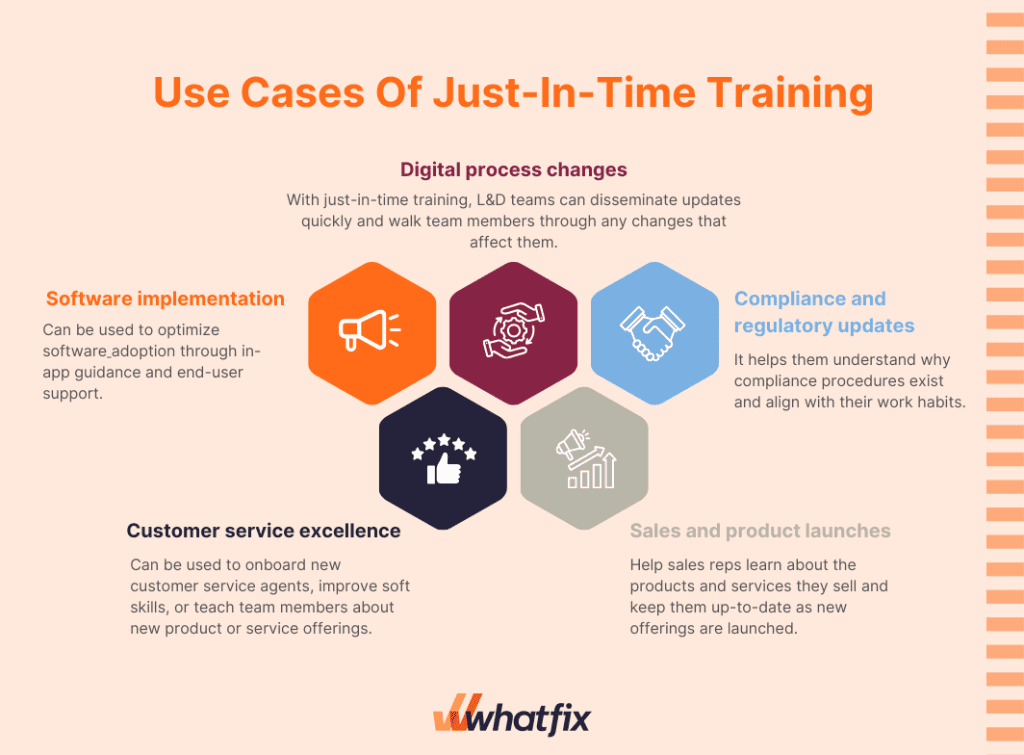What Is Just-in-Time Training? (+Challenges)
- Published: April 2, 2024

Faced with the challenge of rapidly evolving technologies and business practices, traditional, scheduled training sessions often fall short of meeting the immediate needs of the workforce.
Furthermore, people now value their time above all else. And almost 57% of employees expect learning to be delivered just in time, or as needed.
These challenges are the reason behind the rise of just-in-time learning. Just In Time Training (JITT) presents a solution by offering real-time, tailored learning experiences that align precisely with the moment of need. Just-in-time training was initially modeled after Toyota’s Toyota Production System (TPS), which was similarly designed to eliminate waste and overproduction by paring processes down until only the precise amount of parts are produced and delivered to a warehouse as needed for distribution.
This approach not only ensures that employees have access to relevant information exactly when it’s most critical but also significantly enhances the effectiveness and applicability of training.
What Is Just-in-Time Training?
Just In Time Training (JITT) is a learning strategy that provides individuals with the information or skills they need precisely at the moment they are required to perform a task or solve a specific problem. Unlike traditional training models that often occur in settings removed from the actual work environment and well in advance of application, JITT delivers targeted, context-specific training directly in the workflow, ensuring immediate applicability and relevance. This approach enhances learning efficiency, reduces cognitive overload, and significantly improves retention and performance by aligning educational content closely with the real-time demands of the job.
Why Is Just-In-Time Training Effective?
In a world where employees expect to have all the information and resources at their fingertips, L&D teams can use just-in-time training to demonstrate that they understand the value of employees’ time and experience.
By providing bite-sized microlearning and personalized training content on demand, employees are empowered to stay engaged and retain more of the information they learn. This premium on relevance, flexibility, and efficiency helps increase knowledge retention and long-term productivity.
Use Cases Of Just-In-Time Training
Just-in-time training is effective across various workplace circumstances, especially when employees need to learn about a particular topic or how to perform a specific skill quickly. Here are some of the best uses for just-in-time training:

1. Software implementation
Just-in-time training optimizes software adoption by embedding the learning process directly into the user’s journey with the new software. As employees navigate the software, JIIT provides on-demand, in-app guidance, tailored to the specific features or tasks the user is interacting with at that moment.
This real-time educational approach eliminates the need for extensive pre-implementation training sessions, reducing the learning curve and accelerating user proficiency with the software. By offering immediate access to information and practical walkthroughs, JIIT ensures that employees can quickly overcome obstacles and efficiently utilize new software capabilities, leading to a smoother implementation process and faster realization of the software’s benefits for the organization.

2. Digital process changes
As business processes and procedures evolve, employees need to adapt. With just-in-time training, L&D teams can disseminate updates quickly and walk team members through any changes that affect them. This way, employees can practice continuous learning and growth without needing to take significant, regular time off of work to do so. With just-in-time training, employees can absorb essential knowledge, learn about new processes without skipping a beat, and adopt new business processes.
3. Compliance and regulatory updates
In industries where compliance is vital, just-in-time training in the form of in-app support can be deployed to keep employees abreast of any updates to regulations or laws they must comply with. This not only helps employees avoid inadvertently causing trouble for the company, but it also helps them understand why compliance procedures exist and align their work habits with the broader vision, whatever that may be.
4. Customer service excellence
Just-in-time training can be used in customer service training to onboard new customer service agents, improve soft skills, or teach team members about new product or service offerings. Help agents find the information they need to provide accurate information and resolve customer issues quickly. Just-in-time training can also be delivered to customers through self-service knowledge bases and in-app messaging to help them resolve inquiries without contacting an agent.
5. Sales and product launches
Similarly, sales representatives need continuous training to meet evolving consumer demands and keep organizations competitive. Use just-in-time training to help sales reps learn about the products and services they sell and keep them up-to-date as new offerings are launched. With just-in-time training, your L&D team can design engaging learning modules to disseminate this vital information to employees as changes occur.
How To Apply Just-In-Time Training In Your Workplace
Rolling out just-in-time training involves many moving parts, but it doesn’t need to be difficult. Here are some steps you can take to deploy moment-of-need training without a hitch.
1. Understand training scope
As with any L&D initiative, development must start with a deep dive into the needs of customers and employees to determine the training scope. Consult managers and employees across departments and use data from surveys and performance reviews to zero in on knowledge and skill gaps and pick out topics well-suited for just-in-time training.
2. Inventory your current training resources
If your L&D team is sitting on an arsenal of existing training content, it is likely possible to repurpose larger-scale, more traditional lessons into more bite-sized modules. Take inventory of your current training resources and note their different formats, which types of media they include, and determine where they can be separated into shorter, more effective microlearning lessons.
3. Leverage just-in-time training technology
The on-demand, digital nature of just-in-time training requires integrating software like a learning management system, content management system, or digital adoption platform for content creation and easy deployment. Whether you are designing just-in-time learning to be accessed via a self-serve knowledge base, in-app messaging, or both, choose a solution that fits the needs of your employees as well as your organization.
Software clicks better with Whatfix's digital adoption platform
Enable your employees with in-app guidance, self-help support, process changes alerts, pop-ups for department announcements, and field validations to improve data accuracy.
4. Implement, evaluate, and iterate based on training data
Once JIT training is rolled out, it is critical to consult the training data continually. Refer to key benchmarks and analytics tools to assess how employees interact with training materials, and which ones have the most success. From there, you can tweak your workflows and content to improve just-in-time training as your employees and your organization grow.
Throughout this process, communicate with employees and stakeholders to ensure they understand the impact of just-in-time training on individual and company-wide growth and how it can contribute to overarching business goals in the long run.
Benefits of Just-In-Time Training For Your Business
Although the goal of just-in-time training is providing moment-of-need support and learning opportunities for employees and customers, this approach offers numerous benefits to organizations. Here are a few of the most notable advantages just-in-time training can bring
1. Enhanced learning retention
By focusing content on a specific issue, and ensuring lessons only contain the most relevant information, employees can apply what they’ve learned immediately, leading to better retention and recall when similar issues arise.
2. Learning in the flow of work
Because just-in-time learning can come in various formats and can be engaged with quickly, lessons don’t take away from regular work time. Allowing employees to learn in the flow of work enables them to be more likely to find training content valuable and engaging. This contributes to higher productivity rates and a more positive working experience for employees as time goes on.
3. Moment of need support
With just-in-time training, training content reaches employees in their moment of need, so it feels like a saving grace rather than a chore. This minimizes frustration and empowers employees to respond to challenges more effectively, making better real-time decisions.
4. Adaptibility to change
By supporting employees through important changes like process or regulatory updates, just-in-time learning helps employees and larger organizations adapt to change and become more agile. As many industries continue to evolve rapidly, this agility becomes increasingly vital to success.
Challenges and Considerations While Implementing JIT Training
Developing and deploying high-quality JIT training presents L&D teams with a few unique challenges. Consider these potential hurdles when creating JIT training activities to ensure successful implementation
1. Ensuring comprehensive understanding
JIIT learning content must deliver information and instructions accurately and concisely to best assist employees in their moment of need. To combat this challenge, L&D teams can use feedback from stakeholders and employees while creating and revising content to ensure that it is optimally helpful to its intended audiences.
2. Balancing standardization and customization
Personalized learning goes a long way toward improving L&D programs, but it is critical to avoid over-personalizing content to the point where it is not widely accessible or useful, even among employees in the same role. The key here is achieving a balance between standard and customization to create JIT content that addresses a variety of issues and can be used across teams and departments.
3. Measuring effectiveness
Because employees access JIT training in unique, challenging situations, it can be difficult to accurately measure the effectiveness of content. Establish a variety of benchmarks ahead of content creation, and emphasize the importance of user feedback to providing the most effective possible training materials.
When your employees encounter problems at work, set them up for success by implementing in-app guidance and support to help them find solutions and stay productive. Whatfix empowers your employees by delivering tailored, contextual guidance right when it’s most needed, transforming the way they interact with and learn from new software. This approach not only streamlines the learning process but also significantly enhances productivity and software adoption rates across your organization. By choosing Whatfix, you’re not just implementing a tool; you’re investing in a smarter, more efficient way to unlock your team’s potential.
Let Whatfix show you how easy and effective digital adoption can be when employees are supported exactly at their point of need. Schedule a free demo with us today!

Thank you for subscribing!



